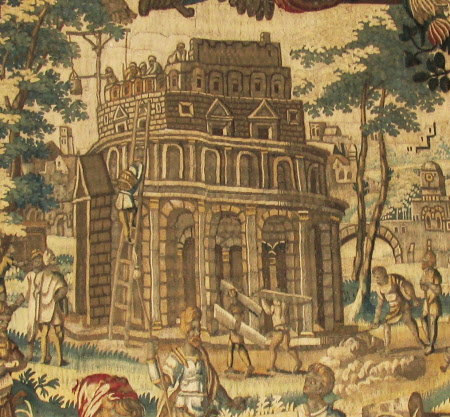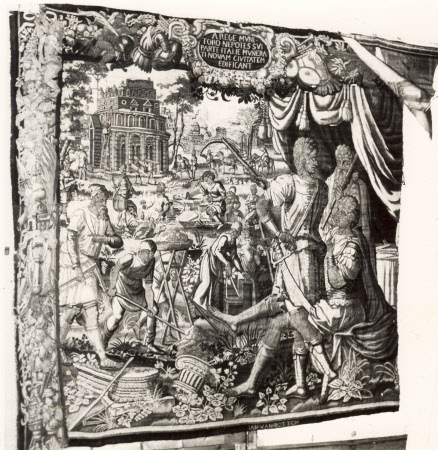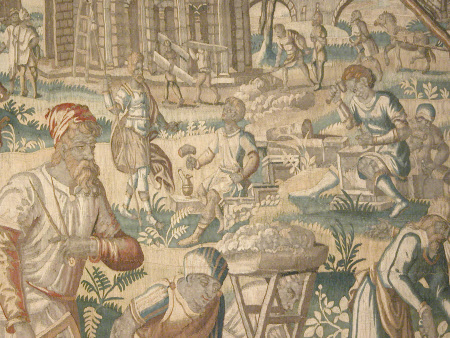The Building of Rome
Jan van Rottom (fl. 1660s)
Category
Tapestries
Date
circa 1660 - circa 1670
Materials
Tapestry, wool and silk, 7-8 warps per cm
Measurements
2750 x 2600 mm
Place of origin
Brussels
Order this imageCollection
Cotehele, Cornwall
NT 348294.3
Summary
Tapestry, wool and silk, 7-8 warps per cm, The Building of Rome from a set of five of the Story of Rome, Jan van Rottom, Brussels, c. 1660-1670. On the right hand side Romulus, Remus and their grandfather Numitor are grouped under a canopy. Remus stands, a sword strapped to his waist, gesturing with a baton in his right hand, Romulus is seated behind him wearing blue scale-armour and behind them stands the elderly Numitor, bearded and holding a staff, a set square and a pair of compasses on a table behind him. The three figures are discussing the building of the city of Rome which takes place on the left hand side of the tapestry. In the foreground are fragments of architectural mouldings and beyond an overseer stands holding a set square and compasses whilst two young men shovel mortar into a tray on a stand, and to the right another man measures a block of stone with compasses. In the background men work stone with chisels and others carry building materials with the help of horse-drawn chariots. At the top left a temple-like building is under construction, and beyond there is a new bridge. In the upper border a central cartouche with a Latin inscription is framed by military trophies and putti carrying palm branches and laurel wreaths; the left hand border has been attached from elsewhere within the set and is composed of a central military trophy with swags of fruit and flowers above and below tied with ribbons which are held up by putti at the top. There is no right-hand border and at the bottom there is no border but a brown galloon inscribed ‘IAN VAN ROTTOM’. The tapestry has been cut and re-joined horizontally across the middle.
Full description
This is the third tapestry in the 'Story of Rome' set at Cotehele. The inscription in the upper border translates as ‘Granted by King Numitor (mis-spelled ‘Munitor’) a part of Italy, his grandsons build a new city’. After the discovery of the true identity of the twins Romulus and Remus, the assassination of Amulius and the restoration of Numitor as King of Alba Longa (see ‘Romulus and Remus before Numitor’, 348294.2), Numitor granted the twins permission to found a new city on the site at which they had been raised – that is, by the hut of the shepherd Faustulus on the Palatine Hill. The tapestry shows the early stages of building, and includes the inauspicious trench which was to mark the city boundary being dug by the feet of the surveyor on the left. Soon after the building had begun the brothers fell out as both wanted the give their name to the new city and to rule it. In some versions of the story Remus disdainfully leapt over the boundary trench to show that Romulus had not the strength to defend the city, and in retaliation one of Romulus’s men murdered him, whilst in other versions Romulus himself killed his brother. The full-scale conflict between the brothers appears in the next tapestry in the series, ‘The Death of Remus’ (348294.4). The tapestry has been in the South Room at Cotehele since at least c. 1840 when it was recorded in a watercolour Nicholas Condy and in the Rev. Arundell’s accompanying description of the Best Bed-Room, as the room was then called (Arundell 1840, p. 27). The five tapestries of the ‘Story of Rome’ at Cotehele may originally have been part of a larger set. The most familiar scene from the story, showing Romulus and Remus suckled by a she-wolf, is not included at Cotehele, and elsewhere surviving weavings from the same cartoons include up to eight different scenes. With the exception of one panel, ‘The Death of Remus’ (348294.4), the designs for the series derive ultimately from a tapestry set woven in the early sixteenth century in Brussels, examples of which were acquired by both Henry VIII and Philip II of Spain in the 1540-50s (Campbell 2007, pp. 306-7; Junquera de Vega & Gallegos 1986, pp. 140-2). The designer of the original series is unknown, but it has been attributed to either Jan Vermeyen (1500-1554) or Michiel Coxcie (1499-1592). In the second half of the sixteenth century a number of tapestry sets were woven based on these designs, in some cases making alterations to the composition and arrangement (Mahl 1965; Salzburg 1987, pp. 350-354). Examples include two sets in the Kunsthistorisches Museum, Vienna, which include the same figure groups but in slightly different arrangements (Mahl 1965). Of all the surviving sets, the one known as Vienna series VIII is compositionally closest to that at Cotehele. The Cotehele tapestries however were woven later, in the second half of the seventeenth century, using updated versions of the sixteenth-century cartoons. The borders with their profusion of military paraphernalia and disporting putti are of a type commonly used on late seventeenth-century Flemish tapestries with classical subject matter. In the centre of each side border is a military trophy consisting of a suit of armour and a helmet propped up on a spear and surrounded by other martial emblems. This form of trophy derives from the memorials erected in ancient Greece and Rome to commemorate victory over an enemy, and was common in funerary sculpture throughout the Renaissance and early modern period. In the context of the ‘Story of Rome’ tapestries the trophies refer to the martial basis upon which Rome was founded. In the centre of each upper border is an oval cartouche with a Latin inscription identifying the subject of the tapestry, and either side are putti with palm branches, symbols of fame, laurel wreaths for victory, olive branches for peace, and ‘fasces’, bundles of rods tied to the shaft of an axe, a symbol of the power and authority of the Roman state. The tapestries were woven without a lower border. Three panels in the 'Story of Rome' set bear the signature of Jan van Rottom, a little-known Brussels entrepreneur whose only other recorded tapestry set is a ‘History of Troy’ dated to c. 1660 (Duverger 1986 A). A fourth tapestry in the set, ‘The Rape of the Sabine Women’ (348294.5), bears the signature of Erasmus III de Pannemaker (Brussels, 1627-1681). De Pannemaker’s signature also appears on a ‘Death of Remus’ tapestry formerly in a private collection in Germany (Duverger 1986 B, p. 114; Göbel 1923, vol. 1, p. 376, vol. 2, pl. 331). Although the main battle scene in de Pannemaker’s ‘Death of Remus’ is completele different to the Cotehele version, the two tapestries have the same border and inscription, and they share a small figure group at the top left with Romulus watching for an augury. Van Rottom and de Pannemaker obviously pooled their resources, sharing design elements such as this small figure group, using the same border designs, and sharing the production of tapestry sets such as Cotehele’s ‘Story of Rome’. It was relatively common for sixteenth-century cartoons to be re-used during the seventeenth century, in part due to the cost of commissioning new designs. Many cartoon painters operating in seventeenth-century Brussels specialised in retouching sixteenth-century cartoons, which were painted in watercolour, to ensure that they remained usable in the workshop (Brosens 2009, p. 363). In the case of the ‘Story of Rome’ not one but two sixteenth-century tapestry series have been recycled, the ‘Story of Rome’ and the ‘History of Scipio’ (see text for 348294.4, ‘The Death of Remus’). The tapestries have been given a new set of inscriptions which differ substantially from those on the sixteenth-century originals: there are many spelling mistakes and grammatical errors, and in some cases, for example ‘Romulus and Remus before Numitor’, the identification of the scene has changed completely. (Helen Wyld, 2010)
Provenance
First recorded at Cotehele c. 1840; left at Cotehele when the property was accepted in lieu of tax from Kenelm, 6th Earl of Mount Edgcumbe (1873-1965) and transferred to the National Trust in 1947; amongst the contents accepted in lieu of estate duty by H M treasury and transferred to the National Trust in 1974.
Credit line
Cotehele House, The Edgcumbe Collection (The National Trust)
Marks and inscriptions
In cartouche in upper border: A REGE MVNI / TORO NEPOTES SVI / PARTE ITALIE MVNERA / TI NOVAM CIVITATEM / EDIFICANT In lower galloon: IAN VAN ROTTOM
Makers and roles
Jan van Rottom (fl. 1660s), workshop
References
Brosens and de Laet, 2009: Koenraad Brosens and Weerle de Laet, ‘Matthijs Roelandts, Joris Leemans and Lanceloot Lefebure: new data on Baroque tapestry in Brussels’, Burlington Magazine, vol. CLI, no. 1275 (June 2009), pp. 360-367 Delmarcel, 1999: Guy Delmarcel, Flemish Tapestry, Tielt 1999 T P Wiseman, Remus. A Roman Myth, Cambridge 1995 Paulina Junquera de Vega and Concha Herrero Carretero, Catalogo de Tapices del Patrimonio nacional, volumen I: siglo XVI, Madrid 1986 Junquera de Vega and Gallegos, 1986: Paulina Junquera de Vega and Carmen Díaz Gallegos, Catalogo de Tapices del Patrimonio nacional, volumen II: siglo XVII, Madrid 1986 Duverger, 1986: Erik Duverger, ‘Een Troje-tapijt uit het Brussels atelier van Jan van Rottom van omstreeks 1660’, Artes Textiles, 11 (1986), pp. 125-148 Duverger, 1969: Erik Duverger, ‘Tapijtwerk uit het Atelier van Frans Geubels’, in De Bloeitijd van de Vlaamse Tapijtkunst, Internationaal Colloquium 23-25 Mei 1961, Brussels 1969, pp. 91-149 Cavallo, 1967: Adolpho Cavallo, Tapestries of Europe and Colonial Peru in the Museum of Fine Arts, Boston, 2 vols., Boston 1967 Elisabeth Mahl, ‘Die Romulus un Remus-Folgen der Tapisserien Sammlung des Kunsthistorischen Museums’, Jahrbuch der Kunsthistorischen Sammlungen in Wien, vol. 61 (1965), pp. 7-40 Fürsterzbischof Wolf Dietrich von Raitenau, Gründer des barocken Salzburg, exh. cat. Residenz Neugebäude & Dommuseum, Salzburg 1987 Marthe Crick-Kuntziger, ‘La Tenture de l’histoire de Romulus d’Antoine Leyniers’, Bulletin des Musées Royaux d’Art et d’Histoire, vol. IV, no. 20 (1948), pp. 50-78 Göbel, 1923: Heinrich Göbel, Die Niederlande, vol. 1 of Wandteppiche, 2 vols., Berlin 1923


